 |
Focus features two in-depth reviews each month of fine art, architecture, and design exhibitions at art museums, galleries, and alternative spaces around Japan. |
|
|
 |
 |
 |
Roka Art Project: A New Destination on Naoshima
Susan Rogers Chikuba |
 |
Ryokan Roka sits on gently sloping land close by Honmura Port and the Art House Project. It runs special exhibits to support emerging talent and is Naoshima's first spot for nighttime gatherings. |
Built on the site of a former rice paddy on the island of Naoshima in the Seto Inland Sea, Ryokan Roka is the vision of Shintaro Sasaki, a fourth-generation hotelier whose family founded the Kifu no Sato ryokan in northern Okayama. Sasaki's discerning eye shows in every micro-decision behind Roka's conception and design, though he is quick to point out that the art-infused inn isn't his brainchild but rather the gheart-childh of everyone on his team. The fact that morning staff meetings conclude with a meditation on mindfulness gives an idea of the engaged welcome you'll find here.
A 2022 work by Ryo Shinagawa anchors the café-bar at Roka. It samples the bird-and-flower paintings that adorned castle residences centuries ago, and uses the same mineral pigments and gold-leaf ground, but renders the flowers with the abstract brushstrokes of expressionism.
|
Naoshima's emergence as a premier art destination dates back to 1985, when the Fukutake Publishing Company (now Benesse Holdings, Inc.) set out to revitalize one of its communities with the establishment of an international campground for youths. That opened in 1989 and was followed soon after by Benesse House (1992), the Art House Project (1998), the Chichu Art Museum (2004), the Lee Ufan Museum (2010), and the Ando Museum (2013) -- and these are but half of the island's art venues shaped by the hand of architect Tadao Ando. Today, Naoshima is the administrative center of Benesse Art Site Naoshima, a destination that extends to the neighboring isles of Teshima and Inujima, and is also a key force behind the renowned Setouchi Triennale, which launched in 2010 and welcomed 1.18 million visitors to its last iteration in 2019.
Roka founder Shintaro Sasaki readies Muryoraku-an, an outdoor hearth where day visitors and overnight guests can mingle over drinks. |
Roka opened its doors in April 2022 on the same day the triennale's fifth installment began. The inn has 11 guest suites, but is more than a place to stay and dine on the famous seafood of the Setouchi region: it is itself an art project. Roka's permanent collection, displayed for now mostly in the restaurant and café-bar, is an incubator for emerging talent; its suites are a gallery for special exhibitions; and its dining venues and outdoor fire pit are places where anyone on the island can hang out with other art lovers and collectors. (In fact, they're the only venues open on the island past 9 p.m.) Over the next three years Sasaki plans to establish studios for short-term residencies, which will lead the way for on-site workshops, master classes, and relaxed dinners with the artists. Hopefully, the inn's permanent collection will see the addition of works by female artists, who aren't yet represented.
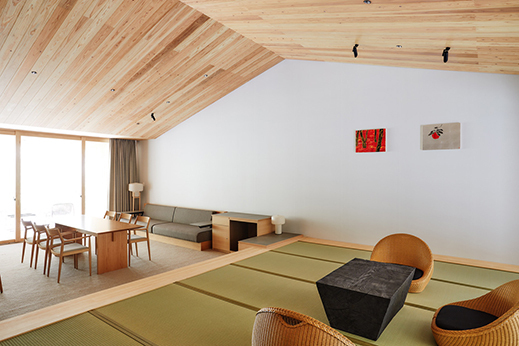 |
|
The Roka Suite can be used for catered art receptions and as a breakout room for workshops and retreats. |
Roka's art program is curated by Shigeo Goto, a professor at Kyoto University of the Arts, where he heads a correspondence course for graduate studies in art and design. A prolific editor and producer known for his publishing collaborations with the likes of Ryuichi Sakamoto, Kishin Shinoyama, Mika Ninagawa, and many others, Goto also runs a subscription-based online salon where he hosts sessions (in Japanese) on how to introduce art-based thinking into business and other endeavors. The plan is for new works he commissions to be shown in the guest suites twice annually -- from April through September for the Spring/Summer collection, and October through March for the Fall/Winter collection. Staying guests have first dibs to purchase the art, by lottery, for the initial three months of each collection. After that, any works not yet spoken for will be released and offered for sale to the general public for online purchasing by lottery until the show's conclusion.
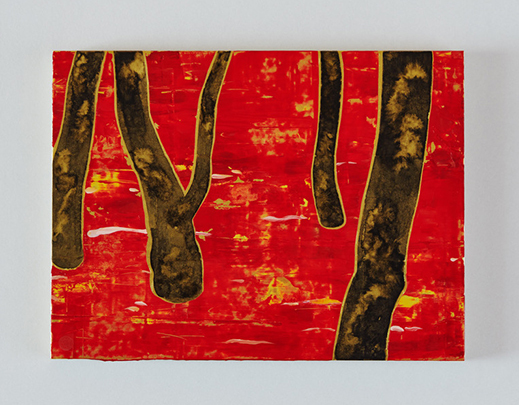 |
|
Though the base poem by Fujiwara no Shunzei is somber in tone, reflecting on the sadness of a garden in autumn and the impermanence of life, Ryo Shinagawa renders his interpretation of it with accents of gold on a fiery red ground. |
Roka's inaugural show is a new series by the Kyoto-based painter Ryo Shinagawa (b. 1987). Shinagawa draws on the centuries-old traditions of Yamato-e and the Kano and Rinpa schools, using the same natural mineral pigments and metal foils, but aims to arrive "at a place Japanese painting might have gone had state-sanctioned definitions of Nihonga not gotten in the way" after the Meiji era (1868-1912). For this show he offers his personal interpretations of 12 poems selected from a canon of Japanese literature: the celebrated imperial anthology Shin kokin wakashu (New Collection of Poems Ancient and Modern).
Night-blooming bottle-gourd flowers (yugao) reference a poem by Fujiwara no Yorizane, which itself alludes to an exchange between Prince Genji and the lover he called by the flower's name. |
Much of the poetry in the Shin kokin anthology is allegorical, pointing at meanings and shared contexts beyond the surface beauty of the fleeting phenomena they describe. Commissioned in 1201 and considered a crystallization of Japanese aesthetics in what was a highly poetic age, the anthology compiles nearly 2,000 poems produced over 500 years by as many poets, and was drawn together as political power shifted from the relatively tranquil days of the Heian court to a time of strife-filled military rule in Kamakura.
Soaked through and yet / these sweet flags remain so fragrant . . . A summer poem by Fujiwara no Yoshitsune recalls an older, anonymous verse that linked blooming irises with love. |
Laurel Rasplica Rodd, a recent translator of the anthology, describes its main aesthetic themes as yugen (qualities of mystery and depth, often involving allusions to a classical past); sabi (darkness and decay -- but also quietude and tranquility); impermanence and ethereal beauty; and a Buddhist notion, commonly held at the time, that the new century marked the dawn of the final Dharma age -- an epoch when teachings are no longer practiced and conflict begins. To such poignant material Shinagawa brings his honed technique and sometimes a bit of humor.
|
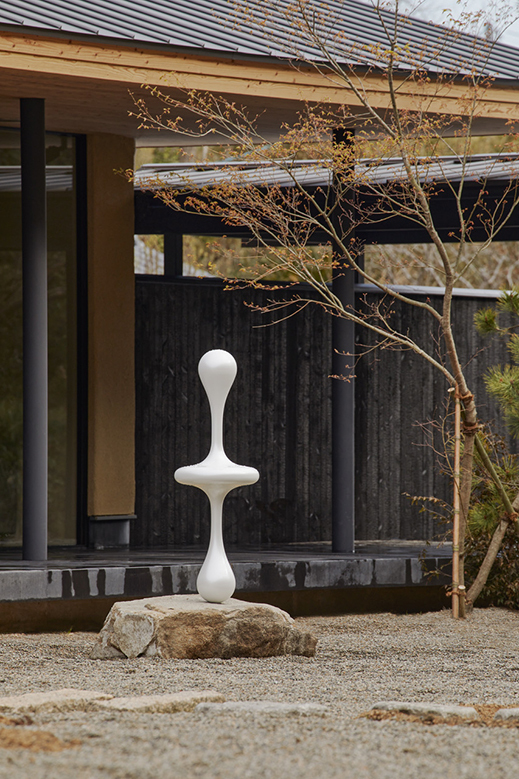 |
|
|
|
Part of Roka's permanent collection, a 2022 work from the Ether series by Kohei Nawa stands in the front courtyard, perfectly poised on a boulder.
|
A first hint of the playful art on display in Roka's permanent holdings is a sculpture in the front courtyard by Kohei Nawa (b. 1975). He modelled the figure after the elastic forms a liquid droplet takes as it falls, then mirrored these vertically to suggest infinity and a virtual state of weightlessness. Inside the café-bar, Alluvion (2021) is a kaleidoscopic print by Daisuke Yokota (b. 1983). He exposed sheets of undeveloped film to light and a cocktail of chemicals to yield polychromatic layers that fissured and bubbled up from the surface, then photographed them. Pit-fired vases by potter Masafumi Shigeta (b. 1985), exhibited at each suite entrance, are a personal favorite. Sasaki fills them himself with flowers and plants he gathers from the surrounding hills. These arrangements can be enjoyed from the main corridor, like a mini-gallery of ikebana.
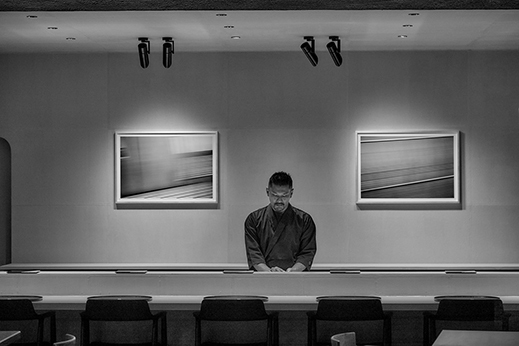 |
|
A diptych from Kohei Nawa's Moment Photography series hangs in the restaurant. It explores notions of representation and materiality through the sculptor's longtime interest in photography. |
Eventually, when facilities are added for short-term artists' residencies, Roka will appear as a small hamlet nestled against a wooded rise. In design it is just as minimalist as the angular structures rendered in Ando's signature concrete that dot the island, but Roka offers yin counterpoint to the Pritzker prizewinner's yang. Or rather, it seeks more of a yin-yang balance within itself: architect Hironori Fujioka of the Okayama-based nottuo Inc. took his inspiration from the five elements of wood, water, fire, earth and air. The accommodations wing is clad in yakisugi charred cedar, a traditional building method of island villages in Japan. Inside, earthen walls give way to softly textured wall coverings of shifu paper cloth and washi paper died a rich dark brown with persimmon tannin, and sliding doors are papered with a work by Sasaki's own hand, entitled Hikari no ame (Rainshine). In the front courtyard, two circular rice paddies are a nod to the site's former function. In name, too, Roka unites the warmth of its outdoor hearth (ro) with the cool qualities of mist (ka) that first inspired Sasaki to build here. On his first visit, he crested the hill just up the road one morning to see mist rising from a reservoir, and was inspired by its yin qualities -- nurturing, reflective, and filled with potential. That, he says, was the moment he knew he had found his happy place for friendly gatherings and creative exchanges centered around contemporary art.
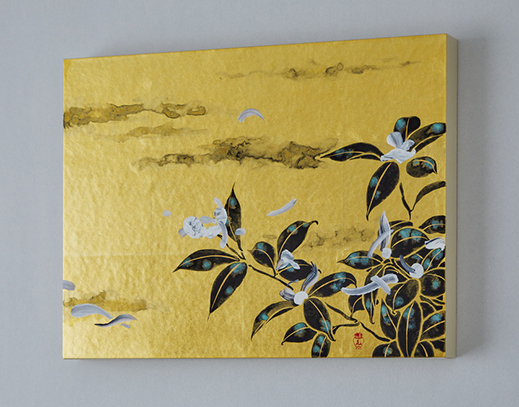 |
|
In another poem alluding to The Tale of Genji, Fujiwara no Teika ponders the scent of wild mandarin orange blossoms carried on a breeze. |
All photos are courtesy of A&C Ltd. |
 |
 |
Susan Rogers Chikuba
Susan Rogers Chikuba, a Tokyo-based writer, editor and translator, has been following popular culture, architecture and design in Japan for three decades. She covers the country's travel, art, literary and culinary scenes for domestic and international publications. |
|
 |
|